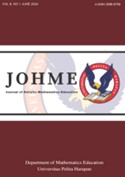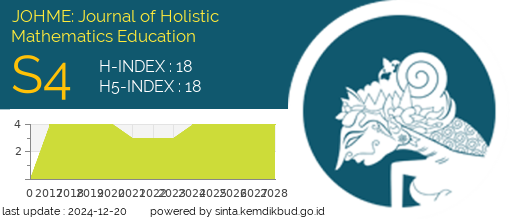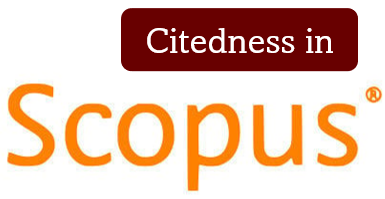STUDENTS’ ERRORS IN PROBLEM-SOLVING REVIEWED FROM THE PERSPECTIVE OF MATH RESILIENCE
DOI:
https://doi.org/10.19166/johme.v8i1.8230Keywords:
students’ errors, problem-solving, Newman procedure, math resilience, trigonometryAbstract
The purpose of this research is to: 1) identify students' mistakes in solving mathematical problems in trigonometry in terms of mathematical resilience according to the Newman Procedure, and 2) discuss trigonometric problems from the point of view of mathematical resilience according to the Newman Procedure. This type of research is qualitative. The research subjects were 3 students from SMA Negeri 1 Slawi, selected using a purposive sampling technique. The methods of data collection are tests, questionnaires, interviews, and documentation. The data analysis techniques used are data reduction, data presentation, and drawing conclusions. Based on the results of the data analysis, we obtained the following: (1) Students' mistakes in reading the questions include: students do not understand the context of the sentence, students do not correctly understand the meaning, and students do not read all the meanings of the desired words. (2) The answers to the questions include: answers that do not contradict the accepted answers but do not coincide with the inquiry accepted in the question, and answers that do not address what is required in the problem posed, often being a question of application. (3) Transforming the problem includes: considering a method being investigated, using the wrong method, and not translating the method to be used. (4) Process skills contain: concept errors, errors in computing, not continuing the settlement procedure, and not processing calculations. (5) The final answer includes: an answer that fits the context of the question, and an answer that does not match the conclusion. The contributing factors include: lack of self-confidence, confusion in describing the problem in the form of a picture, hurrying in solving problems, lack of accuracy, inability to manage time well, inability to think about problems thoroughly, forgetting to identify what is suitable and trying, confusion in determining the formula to be used, and solving the problem without completing the conclusion.
References
Afriyanti, I., Mulyono, & Asih, T. S. N. (2018). Mathematical literacy skills reviewed from mathematical resilience in the learning of discovery learning assisted by schoology. UJMER: Unnes Journal of Mathematics Education Research, 7(1), 71-78. Retrieved from https://journal.unnes.ac.id/sju/ujmer/article/view/24330/11171
Afriyanti, I., Wardono, & Kartono. (2018). Pengembangan literasi matematika mengacu PISA melalui pembelajaran abad ke-21 berbasis teknologi. PRISMA: Prosiding Seminar Nasional Matematika, 1(1), 608-617. Retrieved from https://journal.unnes.ac.id/sju/prisma/article/view/20202/9580
Alhara, Z. H., Asikin, M., & Amidi, A. (2021). Problem solving ability based on Newman procedure in team games tournament learning. UJME: Unnes Journal of Mathematics Education, 10(1), 39-44. Retrieved from https://journal.unnes.ac.id/sju/ujme/article/view/32922/20019
Anggraini, L., Wulandari, S., & Nurmala. (2022). Errors of class VIII junior high school students in solving mathematical communication problems based on the Newman Procedure. Journal of Education and Learning Mathematics Research (JELMaR), 3(2), 103-108. https://doi.org/10.37303/jelmar.v3i2.80
Arjun, M., & Muntazhimah. (2023). The effect of mathematical resilience on the mathematical problem-solving ability of students. AKSIOMA: Jurnal Program Studi Pendidikan Matematika, 12(1), 944-950. https://doi.org/10.24127/ajpm.v12i1.6584
Chu, S., Reynolds, R. B., Tavares, N. J., Notari, M., & Lee, C. W. Y. (2017). 21st century skills development through inquiry-based learning: From theory to practice. Singapore: Springer.
Dirgantoro, K. P. S., Saragih, M. J., & Listiani, T. (2019). Analisis kesalahan mahasiswa PGSD dalam menyelesaikan soal statistika penelitian pendidikan ditinjau dari prosedur Newman. JOHME: Journal of Holistic Mathematics Education, 2(2), 83-96. https://doi.org/10.19166/johme.v2i2.1203
Duah, F. (2017). Mathematics resilience: What is known in the pre-tertiary mathematics education research and what we have found researching non-mathematics-specialists. Proceedings of the British Society for Research into Learning Mathematics, 37(2), 1-6. Retrieved from https://bsrlm.org.uk/wp-content/uploads/2017/08/BSRLM-CP-37-2-11.pdf
Ekayanti, A., & Nasyiithoh, H. K. (2018). Profile of students’ errors in mathematical proof process viewed from adversity quotient (AQ). Tadris: Jurnal Keguruan dan Ilmu Tarbiyah, 3(2), 155-166. https://doi.org/10.24042/tadris.v3i2.3109
Fitriani, Herman, T., & Fatimah, S. (2023). Considering the mathematical resilience in analyzing students’ problem-solving ability through learning model experimentation. International Journal of Instruction, 16(1), 219-240. https://doi.org/10.29333/iji.2023.16113a
Goodall, J., & Johnston-Wilder, S. (2015). Overcoming mathematical helplessness and developing mathematical resilience in parents: An illustrative case study. Creative Education, 6(5), 526-535. https://doi.org/10.4236/ce.2015.65052
Granberg, C. (2016). Discovering and addressing errors during mathematics problem-solving: A productive struggle? The Journal of Mathematical Behavior, 42, 33-48. https://doi.org/10.1016/j.jmathb.2016.02.002
Gürefe, N., & Akcakin, V. (2018). The Turkish adaptation of the mathematical resilience scale: Validity and reliability study. Journal of Education and Training Studies, 6(4), 38-47. Retrieved from https://redfame.com/journal/index.php/jets/article/view/2992/3265
Haghverdi, M., Semnani, A. S., & Seifi, M. (2012). The relationship between different kinds of students’ errors and the knowledge required to solve mathematics word problems. Bolema: Boletim de Educação Matemática, 26(42), 649-665. https://doi.org/10.1590/s0103-636x2012000200012
Halim, F. A., & Rasidah, N. I. (2019). Analisis kesalahan siswa dalam menyelesaikan soal cerita aritmatika sosial berdasarkan prosedur Newman. GAUSS: Jurnal Pendidikan Matematika, 2(1), 35-44. https://doi.org/10.30656/gauss.v2i1.1406
Harsela, K., & Asih, E. C. M. (2020). The level of mathematical resilience and mathematical problem-solving abilities of 11th grade sciences students in a senior high school. Journal of Physics: Conference Series, 1521, 1-7. https://doi.org/10.1088/1742-6596/1521/3/032053
Hasanah, F. J., & Firmansyah, D. (2022). Analisis kemampuan pemecahan masalah ditinjau dari motivasi belajar siswa. Jurnal Educatio, 8(1), 247-255. https://doi.org/10.31949/educatio.v8i1.1959
Jonassen, D. H. (2011). Learning to solve problems: A handbook for designing problem-solving learning environments. New York, NY: Routledge.
Kristayulita, K., & Nusantara, T. (2018). Error analysis of mathematical problems on TIMSS: A case of Indonesian secondary students. IOP Conference Series: Materials Science and Engineering, 296, 1-7. https://doi.org/10.1088/1757-899X/296/1/012010
Kukulska-Hulme, A., Lee, H., & Norris, L. (2017). Mobile learning revolution: Implications for language pedagogy. In C. A. Chapelle & S. Sauro (Eds.), The handbook of technology and second language teaching and learning (pp. 217-233). Oxford: Wiley & Sons. Retrieved from https://oro.open.ac.uk/50366/7/50366.pdfKurnia, H. I., Royani, Y., Hendiana, H., & Nurfauziah, P. (2018). Analisis kemampuan komunikasi matematik siswa SMP ditinjau dari resiliensi matematik. Jurnal Pembelajaran Matematika Inovatif, 1(5), 933-940. Retrieved from https://download.garuda.kemdikbud.go.id/article.php?article=1090878&val=16412&title=ANALISIS%20KEMAMPUAN%20KOMUNIKASI%20MATEMATIK%20SISWA%20SMP%20DI%20TINJAU%20DARI%20RESILIENSI%20MATEMATIK
Lai, C. F. (2012). Error analysis in mathematics. Behavioral Research and Teaching, 1-9. Retrieved from https://files.eric.ed.gov/fulltext/ED572252.pdf
Lastiningsih, N., Mutohir, T. C., Riyanto, Y., & Siswono, T. Y. E. (2017). Management of the school literacy movement (SLM) programme in Indonesian junior secondary schools. World Transactions on Engineering and Technology Education, 15(4), 384-389. Retrieved from http://www.wiete.com.au/journals/WTE&TE/Pages/Vol.15,%20No.4%20(2017)/13-Lastiningsih-N.pdf
Nababan, R., Hutauruk, N., & Perawati, L. (2021). Pengaruh model pakem sistem daring terhadap hasil belajar PKn pada materi perumusan dan penetapan Pancasila sebagai dasar negara siswa kelas VII di SMP Negeri 26 Medan T.A. 2021/2022. Jurnal Darma Agung, 29(3), 448-464. https://doi.org/10.46930/ojsuda.v29i3.1245
Oktaviani, M. (2019). Analysis of students’ error in doing mathematics problem on proportion. 2nd Asian Education Symposium, 1, 172-177. https://doi.org/10.5220/0007300601720177
Öztürk, M., Akkan, Y., & Kaplan, A. (2020). Reading comprehension, mathematics self-efficacy perception, and mathematics attitude as correlates of students’ non-routine mathematics problem-solving skills in Turkey. International Journal of Mathematical Education in Science and Technology, 51(7), 1042-1058. https://doi.org/10.1080/0020739X.2019.1648893
Pambudi, D. S., Budayasa, I. K., & Lukito, A. (2020). The role of mathematical connections in mathematical problem solving. Jurnal Pendidikan Matematika, 14(2), 129-144. https://doi.org/10.22342/jpm.14.2.10985.129-144
Peatfield, N. (2015). Affective aspects of mathematical resilience. Proceedings of the British Society for Research into Learning Mathematics, 35, 70-75. Retrieved from https://bsrlm.org.uk/wp-content/uploads/2016/02/BSRLM-IP-35-2-13.pdf
Prakitipong, N., & Nakamura, S. (2006). Analysis of mathematics performance of grade five students in Thailand using Newman procedure. Journal of International Cooperation in Education, 9(1), 111-122. Retrieved from https://cice.hiroshima-u.ac.jp/wp-content/uploads/2014/03/9-1-9.pdf
Pungut, M. H. A., & Shahrill, M. (2014). Students’ english language abilities in solving mathematics word problems. Mathematics Education Trends and Research, 1-11. https://doi.org/10.5899/2014/metr-00048
Raduan, I. H. (2010). Error analysis and the corresponding cognitive activities committed by year five primary students in solving mathematical word problems. Procedia - Social and Behavioral Sciences. https://doi.org/10.1016/j.sbspro.2010.03.600
Rohmah, S., Kusmayadi, T. A., & Fitriana, L. (2020). Mathematical connections ability of junior high school students viewed from mathematical resilience. Journal of Physics: Conference Series, 1538(1), 1-12. https://doi.org/10.1088/1742-6596/1538/1/012106
Saleh, K., Yuwono, I., As’ari, A. R., & Sa’dijah, C. (2017). Errors analysis solving problems analogies by Newman procedure using analogical reasoning. International Journal of Humanities and Social Sciences, 9(1), 17-26. Retrieved from https://ijhss.net/index.php/ijhss/article/view/253/89
Sari, Y. M., & Valentino, E. (2016). An analysis of students error in solving PISA 2012 and its scaffolding. JRAMathEdu (Journal of Research and Advances in Mathematics Education), 1(2), 90-98. https://doi.org/10.23917/jramathedu.v1i2.3380
Schleicher, A. (2019). PISA 2018 insights and interpretations. Retrieved from https://www.oecd.org/pisa/PISA%202018%20Insights%20and%20Interpretations%20FINAL%20PDF.pdf
Singh, P., Rahman, A. A., & Hoon, T. H. (2010). The Newman procedure for analyzing primary four pupils errors on written mathematical tasks: A Malaysian perspective. Procedia - Social and Behavioral Sciences, 8, 264-271. https://doi.org/10.1016/j.sbspro.2010.12.036
Stacey, K., & Turner, R. (2015). Assessing mathematical literacy: The PISA experience, 1-321. Cham: Springer.
Sutiarso, S., & Rohmah, M. (2018). Analysis problem solving in mathematical using theory Newman. EURASIA Journal of Mathematics, Science and Technology Education, 14(2), 671-681. https://doi.org/10.12973/ejmste/80630
Szabo, Z. K., Körtesi, P., Guncaga, J., Szabo, D., & Neag, R. (2020). Examples of problem-solving strategies in mathematics education supporting the sustainability of 21st-century skills. Sustainability, 12(23), 1-28. https://doi.org/10.3390/su122310113
Tayeb, T., Angriani, A. D., Humaerah, S. R., Sulasteri, S., & Rasyid, M. R. (2018). The students’ errors in answering geometric tests with Newman procedures. Journal of Physics: Conference Series, 1114, 1-8. https://doi.org/10.1088/1742-6596/1114/1/012048
Thomas, D. S., & Mahmud, M. S. (2021). Analysis of students’ error in solving quadratic equations using Newman’s procedure. International Journal of Academic Research in Business and Social Sciences, 11(12), 222-237. https://doi.org/10.6007/ijarbss/v11-i12/11760
Veloo, A., & Krishnasamy, H. N. (2015). Types of student errors in mathematical symbols, graphs and problem-solving. Asian Social Science, 11(15), 324-334. https://doi.org/10.5539/ass.v11n15p324
Widodo, S. A., Darhim, & Ikhwanudin, T. (2018). Improving mathematical problem solving skills through visual media. Journal of Physics: Conference Series, 948, 1-8. https://doi.org/10.1088/1742-6596/948/1/012004
Widodo, S. A., Turmudi, & Dahlan, J. A. (2019). An error students in mathematical problems solves based on cognitive development. International Journal of Scientific & Technology Research, 8(7), 433-439. Retrieved from https://www.ijstr.org/final-print/july2019/An-Error-Students-In-Mathematical-Problems-Solves-Based-On-Cognitive-Development.pdf
Widodo, S. A., & Wahyudin. (2018). Selection of learning media mathematics for junior school students. TOJET: The Turkish Online Journal of Educational Technology, 17(1), 154-160. Retrieved from https://files.eric.ed.gov/fulltext/EJ1165728.pdf
Widodo, S. A., Pangesti, A. D., Kuncoro, K. S., & Arigiyati, T. A. (2020). Thinking process of concrete student in solving two-dimensional problems. Jurnal Pendidikan Matematika, 14(2), 117-128. Retrieved from https://ejournal.unsri.ac.id/index.php/jpm/article/view/9460/pdf
Widodo, S. A., & Turmudi. (2017). Guardian student thinking process in resolving issues divergence. Journal of Education and Learning (EduLearn), 11(4), 431-437. https://doi.org/10.11591/edulearn.v11i4.5639
Wijaya, A., van den Heuvel-panhuizen, M., Doorman, M., & Robitzsch, A. (2014). Difficulties in solving context-based PISA mathematics tasks: An analysis of students’ errors. The Mathematics Enthusiast, 11(3), 555-584. https://doi.org/10.54870/1551-3440.1317
Zakaria, E., Ibrahim, & Maat, S. M. (2010). Analysis of students’ error in learning of quadratic equations. International Education Studies, 3(3), 105-110. https://doi.org/10.5539/ies.v3n3p105Downloads
Published
How to Cite
Issue
Section
License
Authors who publish with this journal agree to the following terms:
1) Authors retain copyright and grant the journal right of first publication with the work simultaneously licensed under a Creative Commons Attribution License (CC-BY-SA 4.0) that allows others to share the work with an acknowledgement of the work's authorship and initial publication in this journal.
2) Authors are able to enter into separate, additional contractual arrangements for the non-exclusive distribution of the journal's published version of the work (e.g., post it to an institutional repository or publish it in a book), with an acknowledgement of its initial publication in this journal.
3) Authors are permitted and encouraged to post their work online (e.g., in institutional repositories or on their website). The final published PDF should be used and bibliographic details that credit the publication in this journal should be included.”










